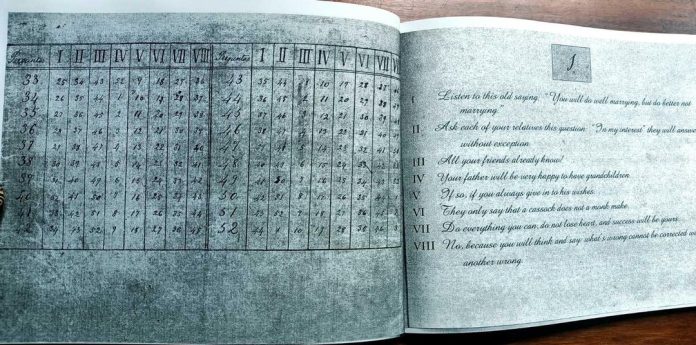Published recently by descendants is an unknown work of José Rizal. Haec Est Sibylla Cumana is not a novel or a collection of poems and essays. It’s a game.
Inspired by the prophecies of Sibyl of Cumae, as depicted by Roman historian Livy and poets Ovid and Virgil, Sibylla Cumana consists of 52 questions about the future, with eight possible answers.
It doesn’t matter how many players join or repeat turns. What’s important is to read aloud the questions and predictive answers.
Sample questions: Will I marry whom I please? Will I be lucky in business? Which shall I choose, the big one or the small one? Should I be hurt by what has happened to me? Is the lack of news deliberate?
For the answer to the question, the player must spin an octagonal top, the sides Roman-numbered I to VIII. When the top falls on its side, the answer corresponding to the number is opened.
Questions and answers can be eerie or hilarious. At the book launch, the publishers demonstrated how to play Sibylla Cumana.
An innocent lass was assigned to handle the top. A guest was requested to pose as the bachelor President to ask Question 34: “Does my family want me to marry?” Spun, the top landed on Number VI. The hall burst into guffaws when the lass read the corresponding answer: “It will be a long wait.”
Another attendee was asked to pose Question 11 on behalf of a wise octogenarian ex-Senate President: “Will I live long?” More laughter when the top pointed to the divination: “Not as much as you deserve.”
A poseur for a detained ex-president with a transactional tenure picked Question 14: “What do they say about me?” In their silence, everyone could hear the top spin and drop on Side III: “Yes, because these days everything is business, even politics.”
Rizal was well-read in many European tongues. He knew that Roman senators consulted the oracle Sibyl to divine the best options, or why the gods were sending calamities. He patterned his game after it.
He was then in Dapitan exile, in 1895, having incensed Spanish authorities with his novels. He kept busy teaching planting to the local lads, arts and crafts to the lasses, and manners to all.
He collected insects and plants, sending specimens to European researchers in exchange for books. Two species were named after him. Winning the lotto, he used the prize to erect a medical clinic.
Josephine Bracken was by his side. Kin often visited for grand reunions; he described in later letters that Christmas 1895 was his happiest.
News from Luzon was troubling. The crackdown on dissent was worsening. The outlook uneased Filipinos. Our great hero rushed to complete Haec Est Sibylla Cumana. Revolución was in the air. First mentioned as probably involved, he was later formally accused and executed, in 1896.
The venerable Carmen Guerrero Cruz Nakpil noted as its publisher: “Maybe, with this final gesture, Rizal was telling us not to be afraid of the future, and was wishing us joy, a light heart, and companionable, group fun.”
The game reveals not only Rizal’s literary but also mathematical depth. He devised a chart (reproduced in the book) of eight columns representing the answer numbers and 52 lines for the questions, with each of the foci assigned a related topic number. Dexterously he whittled the wooden top himself.
Rizal’s humor also shown in Question 38: “Which of the two wears the pants?” And imagination in answering Question 11 with Number V: “A foreigner will ask for your hand. The day after he will ask for a thousand pesetas from your father, who will refuse and be accused of being miserly. Relationships will be broken.”
Sibylla Cumana tells us what was going on in the minds of our forebears at the time. Who would think that Pepe Pimentel jokes were already in vogue then, as Question 51 shows: “Do I have to put up with a mother-in-law in my house?”
Every Filipino would want to have a part of Rizal in the house, and Haec Est Sibylla Cumana is one of the best ways. The set features the main book in the original Spanish. There’s an English translation, This Is Sibylla Cumana, by Gemma Cruz Araneta, descended from Rizal’s brother Paciano, the Katipunan general. And one in Filipino, Si Sibylla Cumana Ito, by National Artist for Literature Virgilio S. Almario.
They come in a box, a replica of the original container when Rizal turned it over to his sister Narcisa Rizal Lopez for safekeeping. How her family guarded it with their lives through the Revolution, the Philippine-American War, and the Japanese invasion is rivetingly detailed in the foreword. Completing the set is a repro of Rizal’s wooden top.
Jarius Bondoc first published this article on Dec. 30, 2011.
Jarius Bondoc is an award-winning Filipino journalist and author based in Manila. He writes opinion pieces for The Philippine Star and Pilipino Star Ngayon and hosts a radio program on DWIZ 882 every Saturday. Catch Sapol radio show, Saturdays, 8 to 10 a.m., DWIZ (882-AM).
The views expressed in this article are the opinions of the author and do not necessarily reflect the editorial stance of LiCAS News.









